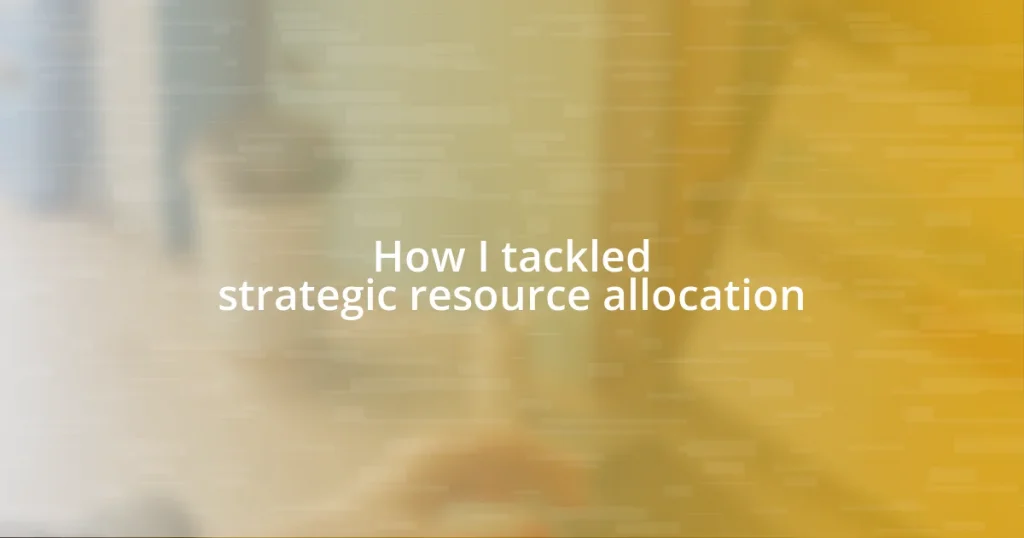Key takeaways:
- Resource allocation strategies require flexibility; adapting to project needs and engaging team members can lead to better outcomes than sticking to rigid structures.
- Identifying key performance metrics that align with project goals enhances team motivation and ensures effective decision-making; balancing leading and lagging indicators is essential.
- Transparent communication about allocation decisions fosters trust and collaboration, while regular monitoring and feedback help adjust strategies to better meet the team’s emotional and operational needs.

Understanding resource allocation strategies
When it comes to resource allocation strategies, I often reflect on the pivotal moments in my career where the right allocation changed the game entirely. I remember a project where we had a limited budget, yet we prioritized human resources—my team delivered exceptional results by leveraging their diverse skills. Isn’t it fascinating how sometimes allocating your best talent can yield more than simply throwing more money at a problem?
What I’ve learned is that there isn’t a one-size-fits-all approach to resource allocation. Each project has its unique needs, circumstances, and challenges. Can you remember a time when shifting your focus from one resource to another created a breakthrough? In my experience, a flexible strategy often trumps a rigid structure; adaptability can turn potential setbacks into unexpected success stories.
Ultimately, understanding where to allocate resources goes beyond just numbers; it’s about assessing value and potential impact. This insight leads me to ask, how do we measure the effectiveness of our allocation strategies? Reflecting on my own experience, I find that regular reviews and feedback loops provide incredible clarity, helping refine the allocation process over time.

Assessing current resource needs
When determining our current resource needs, I’ve found that a thorough self-assessment is invaluable. In one instance, we were gearing up for a major launch, but initial team assessments revealed that many roles were under-resourced. Instead of waiting for the crunch time pressures to surface, we took proactive steps, reallocating skill sets and bringing on temporary support to fill the gaps—something I wish I’d done sooner in previous projects. By engaging my team in these discussions, I not only gathered insights but also inspired ownership and commitment.
To effectively assess current resource needs, consider the following key points:
- Identify existing skill gaps: Regularly evaluate your team’s skill sets against project demands.
- Engage with team members: Conversations about their workload and strengths can reveal unrecognized talents and needs.
- Prioritize urgent projects: Understand which projects require immediate attention to allocate resources more effectively.
- Utilize data-driven assessments: Analyze performance metrics to identify trends and areas for improvement.
- Be flexible and adaptable: Recognize that needs can shift quickly; staying agile in your planning is crucial.

Identifying key performance metrics
Identifying key performance metrics is critical for guiding resource allocation decisions effectively. I’ve discovered that metrics should align closely with project objectives to provide meaningful insights. For example, during a project aimed at boosting customer engagement, we tracked metrics such as user activity levels and conversion rates. This clear focus not only highlighted areas needing improvement but also reinforced the overall project direction, encouraging the team to rally around shared goals.
What I find most engaging about this process is the collaboration it fosters. By involving my team in the selection of performance metrics, I’ve seen increased motivation and commitment. It’s a thrilling experience when a team identifies which metrics resonate most with them; it creates a sense of ownership that drives everyone to strive for better results. Have you ever witnessed your team light up at the thought of measuring their successes? It’s those pivotal moments that transform numbers into a narrative of progress.
Finally, an effective approach to choosing key performance metrics is to categorize them into leading and lagging indicators. Leading indicators give early signs of progress, while lagging indicators reveal past performance outcomes. Understanding this distinction has been a game-changer for me. For instance, I remember a time when we focused solely on lagging indicators and missed opportunities for timely interventions. By balancing both types, I’ve developed a more comprehensive view that enhances our strategic planning.
| Category | Description |
|---|---|
| Leading Indicators | Metrics that predict future performance and can be influenced by current actions, such as customer feedback scores. |
| Lagging Indicators | Metrics that reflect past performance, such as final sales figures or project completion rates. |

Developing a resource allocation plan
Creating a resource allocation plan starts with a clear understanding of priorities. I remember a time when my team had multiple projects simultaneously vying for attention. It was chaotic, and we risked spreading ourselves too thin. By ranking projects based on their potential impact and resource requirements, we created a roadmap that directed our focus. It felt great to see the clarity this provided, allowing us to allocate our resources more effectively.
Once priorities are set, I’ve found it vital to communicate openly with stakeholders about expectations. During one particularly challenging quarter, I scheduled a meeting with my team and leadership to address resource constraints. It was a revelation to see how much transparency shifted our approach. Instead of casting blame or feeling overwhelmed, we collaboratively brainstormed solutions that catered to everyone’s strengths. Have you experienced that kind of positive shift when people come together to tackle challenges? It’s incredibly motivating!
Finally, continuously revisiting and refining the allocation plan is essential for success. I recall a project where we had to pivot due to market changes, which meant reallocating resources on the fly. I learned that staying flexible not only improved our responsiveness but also fostered a culture of innovation within the team. Regular check-ins allowed us to adapt our plan as necessary, ensuring we remained aligned with evolving goals. It’s this iterative process that has led me to believe that a resource allocation plan is never truly finished; it’s a living document that grows with your team’s needs.

Communicating allocation decisions effectively
Effective communication of allocation decisions is as crucial as the decisions themselves. I vividly recall a time when we restructured our budget and had to relay that to the team. Instead of sending an email, I called a team meeting to discuss the changes directly. It was incredibly rewarding to see the team’s faces and engage in a real dialogue. Have you ever seen how a simple discussion can turn confusion into clarity? That day, we transformed anxiety about the changes into a collective sense of purpose and excitement for the upcoming projects.
Being transparent about the reasons behind allocation decisions fosters trust within the team. In my experience, sharing data and insights that support the decisions not only helps people understand the “why” but also invites them to contribute to future decisions. For instance, during a particularly resource-constrained project, I laid out our constraints and how we had to make tough choices. It was enlightening for everyone to see the constraints in light of our broader goals. Wouldn’t you agree that when people understand the reasoning, they’re more likely to rally behind the decisions? That was certainly the case for us, as the team became more proactive in suggesting efficient ways to use our limited resources.
Finally, creating a feedback loop is essential for refining future communication. I structured follow-up sessions to gather input from the team about how they felt regarding the allocation process. The candid feedback was invaluable; some felt they needed more time to adapt to changes while others had innovative suggestions for better efficiency. This open line of communication has not only improved our strategic allocations but also deepened our relationships. Have you ever had that “aha” moment from team feedback? I know I have, and it’s a reminder of the power of effective communication in shaping our path forward together.

Monitoring and adjusting resource use
Monitoring resource use requires constant attention and agility. I once oversaw a project that initially appeared to be on track, but a few weeks in, I noticed certain tasks lagging behind. Instead of waiting for the next scheduled meeting, I organized a quick stand-up session to address the issues. It was eye-opening to see how immediate feedback could ignite a sense of urgency and collaboration among team members. Have you had moments where a small adjustment led to significant progress? Those quick check-ins can be game-changers.
As I continued to monitor our resource allocation, I realized that metrics alone don’t tell the whole story. For example, while looking at our utilization rates, I discovered some team members felt overwhelmed, even though the numbers looked fine. Engaging in open conversations helped uncover the hidden challenges they were facing. I learned that understanding the team’s emotional landscape is just as crucial as hard data, allowing us to adapt resource use in a more meaningful way. How often do you dive deep into the emotional states of your team? It can provide insights that numbers just can’t capture.
Adjusting resource use becomes a more finely tuned process with regular reflection. During one project’s debrief, we discussed what worked and what didn’t, allowing us to recalibrate our strategy for future initiatives. I was amazed at how even a small pivot in resource distribution enhanced our collective output and morale. Has there been a time when small adjustments led to great successes for you? Embracing a mindset that welcomes change can truly unlock a team’s potential and keep everyone focused on shared goals.















